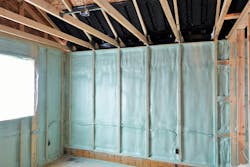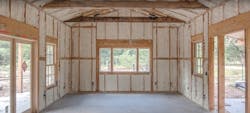Potential home buyers are typically more focused on wall finishes than wall construction. And for good reason: they expect the home to be comfortable and draft free. When it’s not an assumption but an expectation, home builders need to consider more than just the bottom line. BASF’s Brad Townsend breaks down why it’s important to focus on the building envelope.
Being predictable isn’t a bad thing
Traditional insulations are predictable in that they are manufactured to perform and meet specific requirements. While this predictability is good, there is a downside: you can only predict performance for one thing.
“From a builder’s standpoint, you have several layers within a wall that you must control because they all deal with something different,” explains Brad Townsend, National Sales Manager – Residential Construction at BASF. “If we look at fibrous insulation as an example, it gives you good thermal protection when installed properly but no air or vapor control because it’s porous. As a result, you need additional materials to account for those environmental factors that fibrous insulation alone can’t address.”
Completing a wall assembly takes time and coordination and that comes with its own set of challenges. Scheduling is difficult and labor shortages or lack of experience can cause delays. Builders can offset these challenges by using more efficient building materials, especially ones that do more with less.
“We see what’s happening in the industry and we’ve been predicting for a while now that builders are going to need to work more efficiently,” says Townsend. “Right now, closed-cell spray foam is that material when it comes to insulating homes. It’s the only insulation that offers air, water, thermal and vapor control. It even provides additional strength to the structure. What more could a builder ask for?”
This level of predictability also gives a sense of quality and peace of mind, which is valuable to a home builder.
Better builds, happier owners, fewer warranty claims
There’s nothing better than getting a project done on time and on budget. Yet there’s one thing that can put a damper on those warm and fuzzy feelings: a warranty claim. Call backs and small repairs are inevitable but when it comes to a drafty room or wet windowsills, a quick fix might not cut it.
“The comfort of a home is only put to the test by a home owner once they’ve moved in,” explains Townsend. “In the winter, if the master bedroom is colder than the living room, it’s a good indication that you have one or potentially two areas to investigate: the HVAC and the building envelope. When looking for solutions, it’s important to keep in mind that your building envelope is your thermal barrier and is meant to establish the comfort of a home while the HVAC system works with your air barrier to maintain it.
“Time of year is a factor but if a portion of the building heats up or cools down quickly, it’s not a bad idea to have your HVAC service tech make sure there is good charge and air flow. After that, you should focus on your building envelope, because it’s probably not performing as it should.”
Townsend recommends the following two steps:
1. Check your windows. Does the building have low-emissivity windows? Is it on the right surface?
2. Check your interior surface temperatures. Gaps, voids and compressed insulation will compromise the building envelope and will most likely be the culprit behind any discomfort. “I like to compare comfort issues to canaries in a coal mine. If you are in a moist or cold climate – you will likely have more issues in the future.”
With closed-cell spray foam insulation, home builders enjoy greater predictability and more confidence in their overall building envelope. When installed at the right thickness, builders can achieve an insulation that provides air, water and vapor barriers all in one go. Spray foam is formulated with so much research and development that its performance is very reliable. And, because the applicator sprays from stud to stud, providing complete and seamless coverage, there is little opportunity for gaps and voids in the wall cavity.
“Knowing you’re doing it right the first time is great peace of mind for the builder,” says Townsend. “Traditional insulations that require manual installation, like fiberglass, need to be cut, fitted and tucked into wall cavities. Sometimes that insulation gets compressed around piping and wiring. That compression ultimately results in a real loss in R-Value. Next time you look at an insulated wall ask yourself – is that insulation completely touching the exterior sheathing? That’s simply not a concern with spray foam insulation.”
Additionally, closed-cell spray foam helps to create a healthier home environment by keeping allergens where they belong: outside! Yet, with more rigorous regulations and severe weather, many builders still aren’t adapting. With change being inevitable, it makes sense to get ahead and find ways to build better now in order to prepare for the future.
Spray it, don’t say it
As regulations becomes more stringent and potential home owners become more knowledgeable about what goes into a home, builders are going to have to meet these changes head on. So where do they start? By getting the right information from building science experts.
“Misinformation is tricky, especially when it comes to spray foam insulation,” says Townsend. “I’ve been in the residential construction industry since the 80s and I’ve heard all the objections. Is it more expensive? Sure, but it doesn’t have to be with our BEYOND.High Performance approach. Our team works with builders to figure out how to best make building materials, like closed-cell spray foam, work financially and within their method.”
Furthermore, recent extreme weather events are showing builders across North America that old building methods simply are not as resilient as they need to be and events like these are only going to get worse.
“Look at what’s happening in the Midwest right now. Homes are essentially being washed away due to extreme flooding and it’s heartbreaking,” says Townsend. “Closed-cell spray foam insulation is FEMA approved and helps homes stay resilient in flood-prone areas. It’s why it’s such an integral part of our Disaster Durable Solutions. Homes are built to protect and our building science makes that a reality.”
To speak with BASF building science experts and to learn how you can make your next build more comfortable, energy efficient and resilient, click here.
About the Author

BASF
BASF provides innovative technologies and tailored solutions for design and construction challenges. Their multi-disciplinary team of experts assists builders, developers, architects and engineers in building more sustainably and affordably through the use of innovative chemistry and applied building science.

